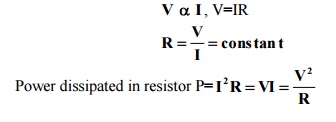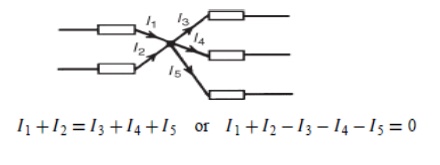Chapter: Electrical and electronics : Circuit Theory
Important Short Questions and Answers: Basic Circuits Analysis
1. Define charge.
The total deficiency or addition of excess electrons in an atom is called its charge. Constant charge is denoted by letter Q and charge varying with time is denoted by q or q (t). Unit of charge is coulomb.
One coulomb of charge is defined as the charge possessed by the total number of electrons.

One coulomb = charge on 6.24x1018 electrons
2.Define current.
Movement of electrons is called current. It is also defined as flow of charges.

Movement of electrons always flow from negative to positive. Unit of current is Ampere.
Current is defined as the rate of flow of charge in an electric circuit or in any medium in which charges are subjected to electric field.

DC current: The current does not vary with time is called direct current. It is denoted by I.
AC current: The current varies with time is called alternating current. It is denoted by i (or)i(t).
3. Define potential difference.
It is also called as voltage (or) electric potential.
It is defined as the energy required moving the unit of charge from one point to other. It is also defined as the difference of electric potential between the two points of the
conductor.

4. Define Power and Energy?
The rate of doing work is called power.
Power P=VI

The rate of doing work with time is called power. It is also called as the capacity to do the
work.
Unit of Energy is Watt-hour (or) Joules.It is denoted by letter E (or) W.
5. What is electric circuit or electric network?
The combination of various electrical elements such as resistors, capacitors and inductors along with various energy sources such as voltage and current sources is called electric circuit or electric network.
6. Define Independent source.
It is defined as the source voltage independent of current flowing through it and source current independent of voltage across it. It is indicated by circle with polarity of voltage and direction of current. It is also called as uncontrolled sources.
Types of independent of sources.

7. Define Dependent sources.
It is defined as the voltage source or current source depends on voltage or current elsewhere in the given circuit. It is indicated by diamond shape. It is also called as controlled sources.
Types of Dependent of sources.
(i)Voltage controlled voltage source (VCVS).
(ii) Voltage controlled current source (VCCS).
(iii) Current controlled current source (CCCS).
(iv)Current controlled voltage source (CCVS).
8.Define ideal voltage source

The energy source which gives constant voltage across its terminals irrespective of the current flowing through its terminal is called ideal voltage source. At any time the value of voltage at load terminals remains same.
9. Define practical voltage source.
Practical voltage source gas small amount of resistance (Rse) in series with voltage source.

Due to Rse, the voltage across load terminals decreases slightly with increase in current.
10. Define time invariant voltage source.

The source in which voltage or current is not varying with time is called time invariant sources. It is also called as DC sources. It is denoted by capital letters.
11. Define time variant voltage source.

The source in which voltage or current is varying with time is called time variant sources. It is also called as AC sources. It is denoted by small letters.
12. Define resistance.

The property of opposition of flow of current is called resistance.
Unit of resistance: ohm
It is denoted by letter R.
Power dissipated in resistor P=I2R
13. Define inductance.

The property of opposition of flow of change in current is called inductance.
Unit of resistance: Henry
It is denoted by letter L.
Energy stored in the inductor E= Li/22
It stores the energy in the form of magnetic field.
14. Define capacitance.

The property of opposition of flow of change in voltage is called capacitance. Unit of resistance: Farad
It is denoted by letter C.
Energy stored in the inductor E=CV2 / 2
It stores the energy in the form of electrostatic field.
15. Define branch and node.
Branch: It is a portion of a circuit with two terminal connected to it. A branch may contain one or more elements.
Node: It is a junction of two or more branches.
16. Define mesh or loop.
It is defined as a set of branches forming a closed path in a network.
17. Define active and passive elements.
Active element: Active elements are the elements which supply power or energy to the network.
Ex. Voltage source, current source
Passive element: Passive elements are the elements which either store energy or dissipate energy in the form of heat.
Ex. Capacitor and inductor=store the energy Resistor=dissipate the energy
18. Define lumped and distributed network.
Lumped network: A network consisting of physically separable elements such as resistor, capacitor and inductor is known as lumped network.
Ex.RLC network
Distributed network: A network consisting of elements that are not separable for analytical purpose is known as distributed network.
Ex. Transmission lines(R, L ad C is distributed along its length)
19. Define bilateral and unilateral network.
Bilateral network: The voltage-currant relationship is same for current flowing in either direction is called bilateral network.
Ex. R, L and C
Unilateral network: The network has different relationships between voltage and current for the two possible directions of current.
Ex: Diodes, vaccum tubes
20. Define linear and non-linear network.
Linear network: The relationship between voltage and current is linear, then the network is called linear network.
Ex:Resistance
Non-Linear network: The networks which do not satisfy the linear voltage-current relationship is called non-linear network.
Ex: Diodes, Zener Diodes
21. State Ohm’s law.
At constant temperature. the current flowing through the resistor is directly proportional to voltage across the resistor.

Power dissipated in resistor
22. Write the limitations of ohm’s law
(i)It is not applicable to non-linear devices such as diodes, zener diodes and voltage regulators
(ii)It is not applicable for non metallic conductors. Ex. silicon carbide
(iii)It is not applicable for arc lamps, electronic valves and electrolytes.
23.State Kirchoff’s current law.

It is also called as point law (or) Kirchoff's law.
It is defined as algebraic sum of currents meeting at any node is equal to zero. (Or)
At any node, sum of incoming current is equal to sum of outgoing current
Sign convention:
Positive: current flowing towards junction. Negative: current flowing away from junction.
24. State Kirchoff’s voltage law.

It is also called as mesh law (or) loop law (or) Kirchoff’s second law.
It is defined as algebraic sum of voltages around any closed path is equal to zero. (Or)
At any closed path, sum of voltage rise is equal to sum of voltage drop
Sign convention:
Voltage rise: current flowing from –ve to +ve terminal of battery. It must be taken as positive. Voltage drop: current flowing from +ve to -ve terminal of battery. It must be taken as
negative.
25. Write the characteristics of series connection of resistances.

(i)Same current flows through each resistance.
(ii)Supply voltage V is the sum of individual voltage drops across each resistance.
V=V1+V2+V3
(iii)Equivalent resistance is equal to sum of individual resistance.
Req= R1+R2+R3
(iv)Equivalent resistance is the largest of all individual resistance.
Req> R1,R2,R3
Ex. Decoration lamps.
Related Topics